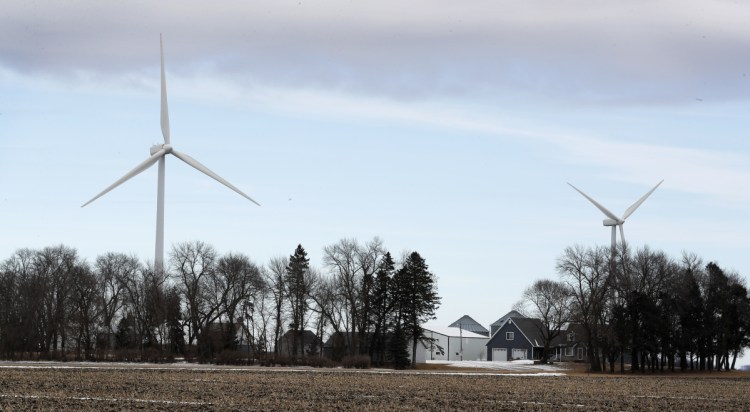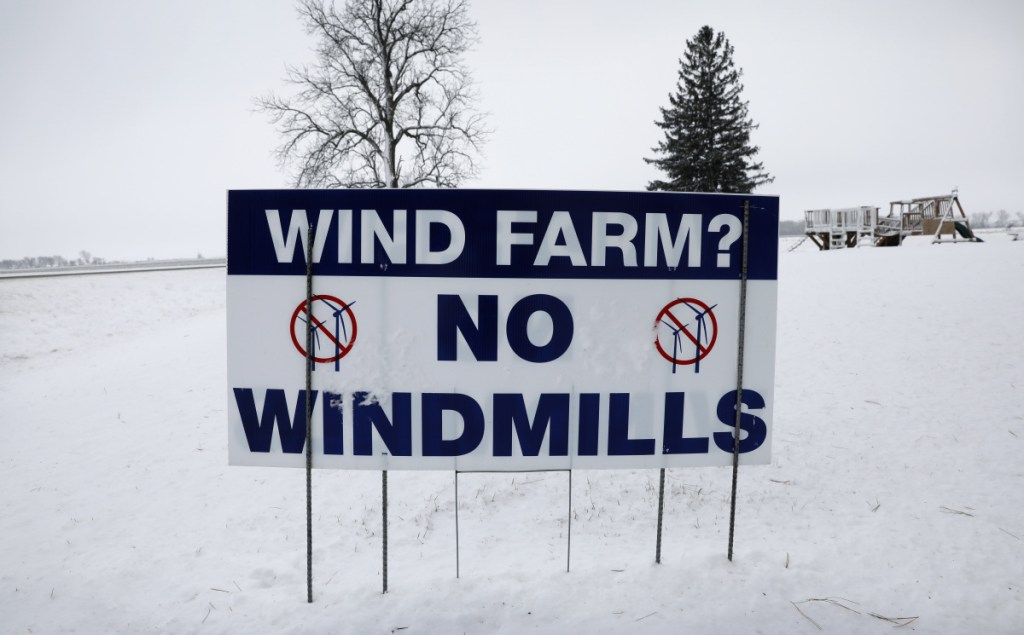GLENVILLE, Minn. — Wind turbines have become as commonplace in parts of the rural Midwest as tree-sheltered farmhouses, gray-metal grain bins and deeply furrowed fields. The slowly spinning blades are a sign of investment in a region that often has few growth opportunities to brag about.
But when a developer sought to put up dozens more of the 400-foot towers in southern Minnesota, hundreds of people in the heart of wind country didn’t celebrate. They fought back, going door-to-door to alert neighbors and circulating petitions to try to kill the project. They packed county board meetings, hired a lawyer and pleaded their case before state commissions.
“I’ve had more neighbors in my living room in the last six months than in all the years we’ve lived here,” said Dorenne Hansen, a leader in the effort whose family has farmed in the area for more than a century.
The criticism has worked so far, stalling the development. Although opposition to wind power is nothing new, the residents of Freeborn County are part of a newly invigorated rebellion against the tall turbines. These energized opponents have given fresh momentum to a host of anti-wind ideas and successfully halted projects across the country.
Some wind developments are still moving ahead, especially in sparsely populated areas, but the success of opposition groups shows that when residents put up organized opposition, they often win.
Wind power remains broadly popular, drawing support from environmentalists who worry about global warming, landowners who welcome a new stream of steady income and local governments seeking more tax revenue. For supporters, wind seems to offer something for everyone: carbon-free electricity, construction and maintenance jobs, and competitive utility rates.
Those factors have fueled incredible growth in the industry, which the American Wind Energy Association says operates more than 54,000 turbines in 41 states, Guam and Puerto Rico. The amount of electricity generated by wind has grown more than fivefold from a decade ago.
Much of the opposition is centered in the Midwest, which has the nation’s greatest concentration of turbines. Opponents have banded together to block wind projects in at least half a dozen states, including Nebraska, South Dakota, Indiana and Michigan. Disputes are still being waged in Iowa, Minnesota, Illinois and Maryland. Intense opposition also exists in parts of the Northeast, including Maine, New York and Vermont.
For many critics, their opposition starts with a simple disdain for the metal towers that support blades half the length of a football field. They want the views from their kitchen window or deck to be of farmland or hills, not giant wind-harnessing machinery.
Others cite grievances that have long circulated on the internet from people living near the towers. They claim the turbines make them dizzy, irritable and unable to sleep. The whooshing noise and vibration from the blades, they say, force them to close windows and blinds and use white noise to mask the mechanical sounds.
Still other homeowners fear for their property values, as fewer people will want to buy a home overlooking a wind farm.
The wind industry says there are no independent studies proving the turbines cause health problems. And in many cases, they argue, wind farms boost property values because developers pay to upgrade surrounding roads, and tax revenue generated by the industry offsets property taxes for homeowners.
Some wind supporters believe that fossil-fuel industries help fund organizations that oppose wind developments. Studies and claims by those groups then can motivate grassroots groups, said David Anderson, a policy manager with the New Hampshire-based Energy and Policy Institute, which supports renewable energy options.
Dan Litchfield, a senior manager at Invenergy, one of the world’s largest wind-energy developers, blames much of the opposition on misinformation but acknowledges that some resistance persists even when neighbors are provided with full details. “A lot of people tell me they like the look of wind turbines,” he added. “They find them graceful.”
That wasn’t the view in Lincoln County, South Dakota, where residents successfully urged officials to block a proposed 150-turbine development. When the wind power company collected signatures and put the matter on the ballot, opponents easily prevailed in the vote.
Other than people who would earn money from leasing their land for the turbines, nearly everyone opposed the plan, said David Brouwer, who has lived for nearly 30 years outside Sioux Falls.
It’s been nearly seven months since the vote that decided the matter, and hard feelings still linger among those on opposing sides of the issue, he said.
“The reality is, it breaks the community up,” Brouwer said. “There are people who were lifelong friends, and they see each other in church and won’t even talk to each other again.”
In Maine, plans to erect turbines atop ridges have outraged people worried about marring the rugged landscape and hurting tourism. The group Friends of Maine’s Mountains has been fighting wind-energy developments in the state Legislature, before regulatory panels and in the courts. It has managed to slow or stop nearly all of the proposals.
Group spokesman Christopher O’Neil said he knows wind farms remain popular with many people in distant, more populated areas near Portland or elsewhere in New England.
“Lots of folks in Portland in their BMWs and fine dining restaurants are OK knowing those country bumpkins are getting those wonderful wind turbines so we can have a clean, green conscience,” O’Neil said.
Tim Hemphill, who grows corn and soybeans on 160 acres in northwest Iowa, appreciates the nearly $30,000 he earns annually from two turbines on his land, especially when crop prices are low. He used to live near the towers until he began turning more farming duties over to his son.
“I wish I had a dozen more. I’d take all I could get,” he said. “I just don’t understand the reasons people oppose them.”
The opposition also frustrates Gregg Townsend, the auditor in Tipton County, Indiana, who said activists would “gin up anger and frustration” in many counties. He blames them for stopping wind projects in Tipton and at least six other Indiana counties. “They’ll buy matching T-shirts and organize a group, then flash mob the commissions or zoning boards of appeals,” Townsend said.
Local officials become intimidated and end up rejecting projects despite the desperate need for tax revenue, he said.
Heidi Gaston, an obstetrics doctor and one of Dorenne Hansen’s children, built a wrap-around porch specifically to enjoy the view and the silence of southern Minnesota. She and her husband can’t imagine staying in their home if seven turbines are erected within a mile.
“We moved here hoping for a peaceful country setting,” Gaston said. “And that’s certainly not what we’d have.”
Send questions/comments to the editors.




Comments are no longer available on this story